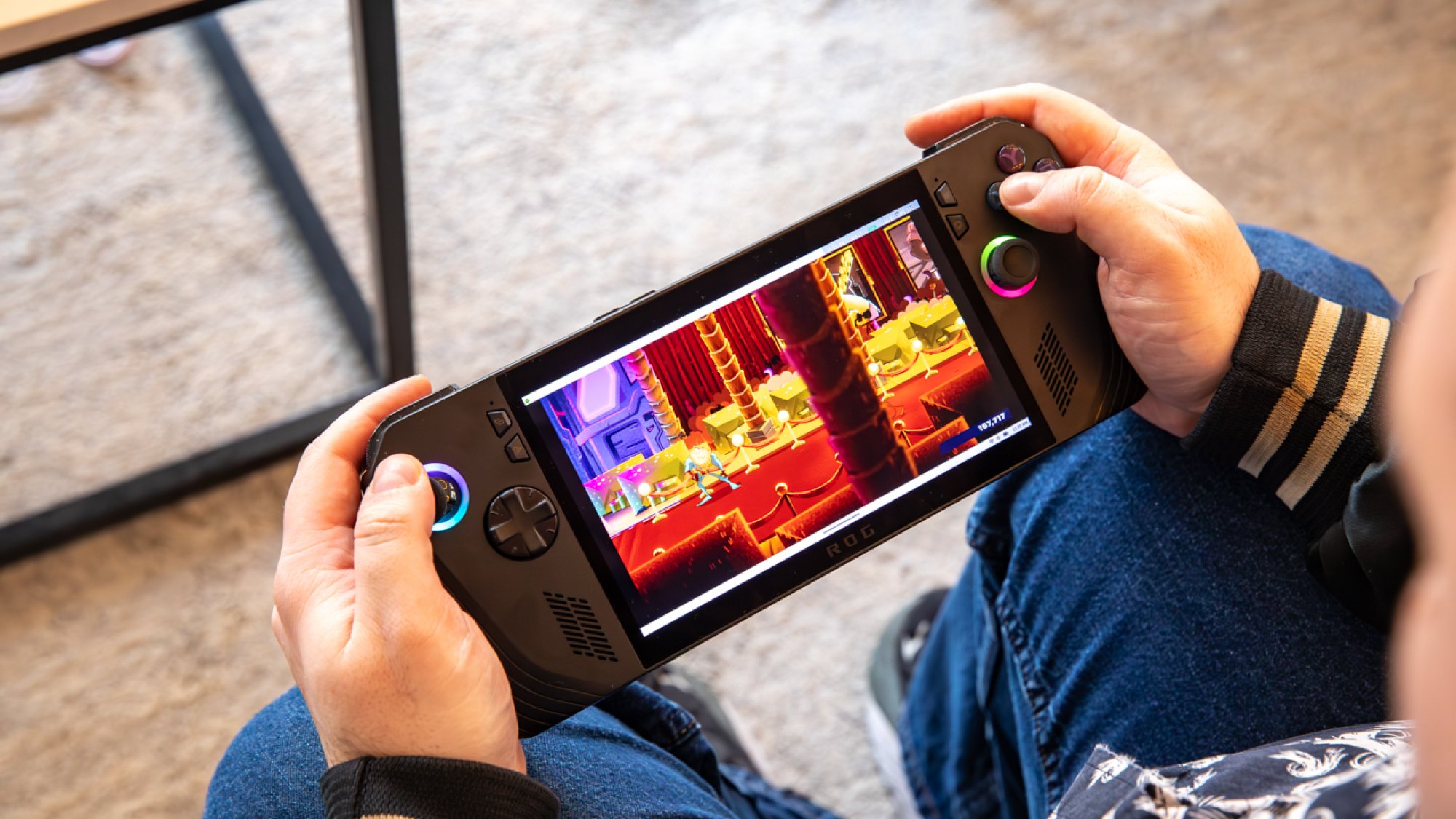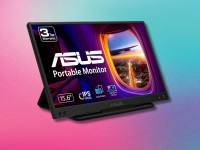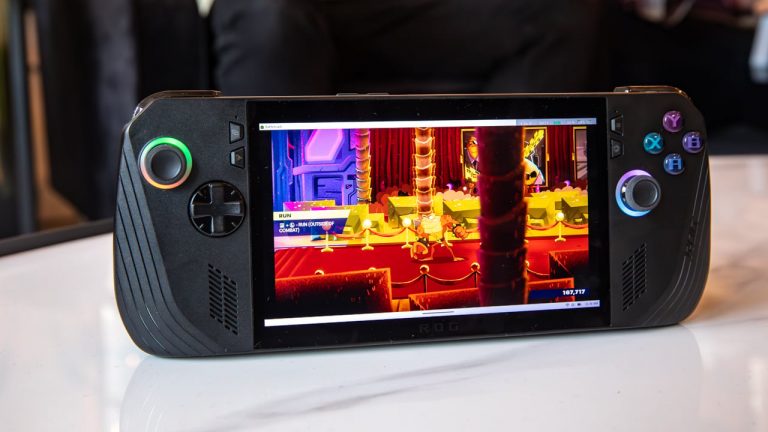
The Asus ROG Ally X is like when you meet your crush’s hot brother. Your crush is cute and all, but his brother? He’s more refined, more mature, and more attractive.
Similarly, the ROG Ally X, a slight upgrade from the ROG Ally, isn’t too different from its sibling. No, the tweaks won’t have you screaming, “Stop the presses!”, but they bring an air of sophistication to the ROG Ally X. They’re intentional and purposeful, signaling that Asus has been listening to user feedback.
For one, the ROG Ally X no longer comes in white. Woo-hoo!
I know Asus likely wanted to stand out of the crowd with a white chassis for the ROG Ally X. After all, most of the Steam Deck wannabes have black models. However — and many gamers will agree with me when I say this — a white handheld gaming console will expose my snacking habit with tell-tale stains. And we don’t want that!
Although this ain’t no ROG Ally 2, this handheld gaming PC still holds its own in a Steam Deck-dominated market.
Asus ROG Ally X price and specs
The ROG Ally X costs $799 and comes with the same CPU and GPU as its predecessor, but there are some minor differences.

Credit: Joe Maldonado / Mashable
Before diving into Asus’ tiny tweaks, allow me to list the specs:
-
AMD Ryzen Z1 Extreme processor
-
AMD Radeon GPU
-
24GB LPDDR5 on-board RAM
-
1TB of SSD storage
As mentioned, the processor and graphics have remained the same on ROG Ally X, but the RAM got upgraded from 16GB to 24GB while the 512GB storage got doubled to 1TB. This will give us a slight uptick in performance, as you’ll find out in subsequent sections.

Opens in a new window
Asus ROG Ally X design
Woo-hoo! The ROG Ally X now comes in black. I can now hide my tendencies to pig out while gaming. I could have Dorito-stained fingers all I want — and my ROG Ally X won’t betray me.

Credit: Joe Maldonado / Mashable
On the right side, you’ll find A, B, X, Y buttons sitting above the right analog stick. Next to the X, you’ll find two buttons: a Menu button (depicted with a trio of lines) and the Armoury Crate button (leads you Asus’ control center).
On the left side, you’ll find another duo of buttons: the View and Command Center buttons. The directional buttons, also known as the D-pad, sits to the bottom right of the left analog stick.

Credit: Joe Maldonado / Mashable
My gripes are the Menu, Armoury Crate, View, and Command Center buttons: the symbols are too subtle and difficult to see. A brighter white for the icons would be nice. Plus, I wish the analog sticks were more symmetrical. However, the buttons and sticks are sturdy, steady, and clicky (and tighter and more resistant compared to the OG ROG Ally).
As a cherry on top, the sticks have LED light rings that add a gorgeous design touch to the ROG Ally X.
On the top, as expected, you’ll find the right and left bumpers and triggers.
On the back, you’ll find the programmable M1 and M2 buttons with satisfying tactile feedback. On the OG ROG Ally, these buttons used to sit annoyingly on top of the grips, but now they’re away from your fingers. On the underside, you’ll also find air vents and a diagonal, lustrous strip to add some eye-catching detail.
Weight and feel
The ROG Ally X is slightly heavier than the 1.4-pound Steam Deck OLED with a weight of about 1.5 pounds. However, it’s much lighter than the Lenovo Legion Go, which weighs about 1.9 pounds.
For what it’s worth, the OG ROG Ally’s weight matched the Steam Deck OLED.
-
Steam Deck OLED – 1.4 pounds
-
Asus ROG Ally – 1.4 pounds
-
Asus ROG Ally X – 1.5 pounds
-
Lenovo Legion Go – 1.9 pounds
Out of all three, however, I still find the Steam Deck OLED to be the most comfortable. The ROG Ally’s grips, where your hands are wrapped around while gaming, don’t protrude as much as the Steam Deck, which is a downside. The Steam Deck’s bulging grips give me more to hold on to during gameplay, providing a more comfortable experience.
But compared to the OG ROG Ally, the ROG Ally X does have fuller grips, which is a plus. And it’s less bumpy, too, for a smoother feel.

Credit: Joe Maldonado / Mashable
If you’re coming from a Steam Deck to an ROG Ally X, you’ll definitely notice the slight dip in comfort. If you’re coming from the Legion Go, however, you’ll find the ROG Ally X to be more comfortable — and lighter, too.
If you’re new to handheld gaming PCs entirely, you likely won’t notice any discomfort at all.
Asus ROG Ally X display
The ROG Ally X still sports the same 7-inch, 1080p display with a 120Hz refresh rate, but that’s OK because, in the words of Bruno Mars, “girl you’re amazing, just the way you are.”

Credit: Joe Maldonado / Mashable
Plus, the ROG Ally X is the only handheld gaming PC that supports a variable refresh rate. This means that, depending on what you’re doing, the refresh rate can drop down to lower values or skyrocket to 120Hz. This way, it’s not constantly churning out high frame rates and wasting energy.
It would be nice, though, to see an OLED panel on the ROG Ally X. It still sports an IPS screen. (The Steam Deck OLED has richer panel, in my opinion.)
I played Cyberpunk 2077 on the ROG Ally X, and no, the visuals won’t blow you away or anything, but it has just the right amount of crispness and sharpness — and vividness — to help you enjoy your favorite games, particularly while you’re on-the-go. The ROG Ally X has 500 nits of brightness, which isn’t as bright as the Steam Deck OLED’s 600-nit display, but it can still hold its own while gaming outdoors.
The Steam Deck OLED also has a slightly bigger display at 7.4 inches. The Lenovo Legion Go’s 500-nit panel is even larger, with an 8.8-inch display, but I find it to be a bit too unwieldy. The 7-inch territory is the sweet spot.
Asus ROG Ally X ports
The Asus ROG Ally X added an extra USB-C port (a Thunderbolt 4 port at that).

Credit: Joe Maldonado / Mashable
This opens you up to a world of eGPUs and docks. Personally, I found myself keeping one port connected to my charging cable and the other connected to my Viture Pro XR glasses (for a sweet virtual display experience).

Credit: Joe Maldonado / Mashable
Here are all the ports you’ll find on the ROG Ally X:
-
USB Type-C (3.2 Gen 2)
-
Thunderbolt 4
-
microSD card reader
-
3.5mm combo audio jack
This is definitely a step-up over the Steam Deck and Lenovo Legion Go, which only have one USB-C port.
Asus ROG Ally X audio
The ROG Ally X has a dual-speaker setup. You can find this up-firing speaker set on the front, with one sitting below the D-pad and the other under the right analog stick.

Credit: Joe Maldonado / Mashable
I downloaded the Apple Music app on the Asus ROG Ally X. (I can do that because, as I’ll explain later, the ROG Ally X runs on Windows.) And to my surprise, the sound on the ROG Ally X is a lot better than I thought it would be. I fired up Sabrina Carpenter’s “Espresso,” and at max volume, the spunky tune sounded loud, bombastic, and impactful.
While playing Cyberpunk 2077, the audio was able to overpower the loud fans that would disturb my ears while Performance Mode is on.
Plus, the sound actually has some depth — and a well-rounded quality to it, too. The Steam Deck, on the other hand, can sound a bit tinny. The ROG Ally X is definitely louder, too.
For what it’s worth, unlike the OG ROG Ally, the ROG Ally X has a new Smart AMP feature that boosts audio and delivers clearer sound.
Asus ROG Ally X benchmarks and performance
The ROG Ally X has the same internals as the OG ROG Ally, but there’s a slight performance uptick. This could be due to the extra RAM on the Ally X, which means you’ll have a bit more headroom for triple-A games that demand a lot of video memory.
I ran Geekbench 6, which tests processor performance, on the ROG Ally X, and it got a multi-core of 12,233 (a 6% performance increase compared to the OG Ally X). The Legion Go, on the other hand, has a Geekbench score of 10,414.
I also ran 3DMark’s Time Spy, which tests for graphics prowess, on the ROG Ally X. It notched a score of 3,477 compared to the Legion Go’s 2,982 figure.
Unlike the ROG Ally X and the Legion Go, which are handheld PCs running on Windows, the Steam Deck OLED has a Linux-based operating system, so benchmarking was a little bit tricky. We don’t have Geekbench nor Time Spy figures for the Steam Deck.
However, we ran the Cyberpunk 2077 benchmark on the Steam Deck (non-OLED version), and we got 30 frames per second (fps). The ROG Ally X pushed out more frames with a score of 47 fps. The Legion Go, on the other hand, also has a 30 fps cap on the same benchmark.
-
Steam Deck – Cyberpunk 2077 – 30 fps
-
Lenovo Legion Go – Cyberpunk 2077 – 30 fps
-
Asus ROG Ally X – Cyberpunk 2077 – 47 fps
It’s also worth noting that, compared to the OG ROG Ally, the ROG Ally X has a full-sized SSD, which can lead to better performance, zippier read/write speeds, and quicker load times.
Asus ROG Ally X battery life
Asus said that it doubled the battery on the ROG Ally X from 40Whr to 80Whr, promising three to eight hours of battery life.
We ran the PCMark 10 gaming battery life test on the ROG Ally X and it lasted 2 hours and 48 minutes. On the same test, the Lenovo Legion Go only lasted 1 hour and 46 minutes.
If it weren’t for the bigger battery, the ROG Ally X would sill be seeing Legion Go-level battery runtimes.
We couldn’t run PCMark 10 on the Steam Deck, but anecdotally, Mashable’s Alex Perry said he got about three-and-a-half hours on it.
Asus ROG Ally X software and Windows
The Asus ROG Ally X running Windows is a blessing and a curse. On the plus side, you can download games from anywhere, whether it’s Steam, the Epic Games Store, Ubisoft Connect, Microsoft Store, and more.
The downside is that setup is a pain. It’s like setting up any Windows PC where you’re dodging subscription pushes left and right, from Microsoft 365 to Xbox Game Pass. And that’s on top of setting up the Wi-Fi, keyboard language, PIN number, inputting your Microsoft account, and more. Next, you have to navigate Windows, mostly with your fingers via the touchscreen, to download all your games, which can be quite the task.
With the Steam Deck on the other hand, setup is a lot more seamless. Input your Wi-Fi password before signing in with your Steam credentials, and voila, you’re in. Of course, the con here is that there are some limitations with SteamOS (unless you want to go through the process of tinkering with the Steam Deck to install Windows).
Asus ROG Ally X worth it?
The Asus ROG Ally X, compared to the OG Ally, has a slight performance boost and better battery life.
Pinning it against the Steam Deck, the ROG Ally X beats it in three ways: better frame rates on triple-A titles like Cyberpunk 2077, a convenient extra USB-C port (i.e., Thunderbolt 4), and better audio.
However, I’d argue that the Steam Deck still continues to have the best ergonomic design as well as the better operating system with SteamOS.
I enjoyed playing on the ROG Ally X, and yes, I totally recommend it for anyone looking for a Steam Deck alternative.






















0 Comments